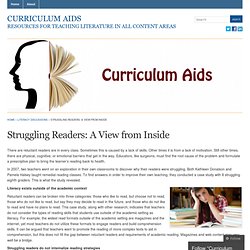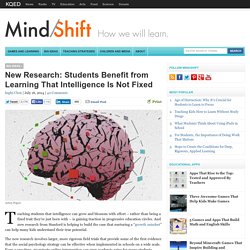

Pottermore - a virtual world for Harry Potter fans. 25 Things Skilled Learners Do Differently. Students' expectations of education. Struggling Readers: A View from Inside. There are reluctant readers are in every class.

Sometimes this is caused by a lack of skills. Other times it is from a lack of motivation. Still other times, there are physical, cognitive, or emotional barriers that get in the way. Educators, like surgeons, must find the root cause of the problem and formulate a prescriptive plan to bring the learner’s reading back to health. In 2007, two teachers went on an exploration in their own classrooms to discover why their readers were struggling. The Why, How, and What of Student e-Portfolios.
The School in the Cloud. Suneeta Kulkarni is Research Director of the School in the Cloud, an initiative that aims to spark creativity, curiosity and wonder in children and inspire them to take control of their own learning in Self Organized Learning Environments (SOLEs).There are seven SOLE Labs at present, one of them on the outskirts of Pune, in Phaltan. The Schools in the Cloud follow-on from Sugata Mitra's Hole in the Wall experiment of 1999, in which groups of children from low-income neighbourhoods, with little or no knowledge of English and no exposure to computers, learnt to use computers by themselves.
Over the next few years, through many experiments, Mitra learned that children with access to computer and related technology are capable of successfully answering examinations without traditional schooling. By 2012, teachers around the world were using the Self-Organised Learning Environments, where children would group around internet connections to learn. Background Challenges. The e-textbook transformation. A new wave of e-textbooks is giving students more than just words and a few hotlinks on a digital page.

Publishers over the last few years have been adding video, interactive maps and gamified quizzes designed to engage students more deeply in their learning. “Think of it as making the textbook a hands-on activity,” says Andrew Miller, an ASCD faculty member and technology expert. “It’s making the content come to life in a way that meets the needs of different learners—auditory learners, visual leaders, text-based learners.”
The latest e-textbooks, developed by traditional publishers as well as new players like Discovery Education, are powered by a host of adaptive features, such as adjustable levels of difficulty and instant translation into other languages. And in some districts, teachers are using platforms like Apple’s iBooks to create their own digital course materials. Boosting test scores The district also uses Discovery’s biology and social studies techbooks. New Research: Students Benefit from Learning That Intelligence Is Not Fixed. Arten Popov Teaching students that intelligence can grow and blossom with effort – rather than being a fixed trait they’re just born with – is gaining traction in progressive education circles.

And new research from Stanford is helping to build the case that nurturing a “growth mindset” can help many kids understand their true potential. The new research involves larger, more rigorous field trials that provide some of the first evidence that the social psychology strategy can be effective when implemented in schools on a wide scale. Even a one-time, 30-minute online intervention can spur academic gains for many students, particularly those with poor grades. The premise is that these positive effects can stick over years, leading for example to higher graduation rates; but long-term data is still needed to confirm that.
However, all the original intervention studies were small and left some educators and policymakers unconvinced. A Light Touch Leads to Meaningful Change.
The new digital learning playbook: understanding the spectrum of students’ activities and aspirations.